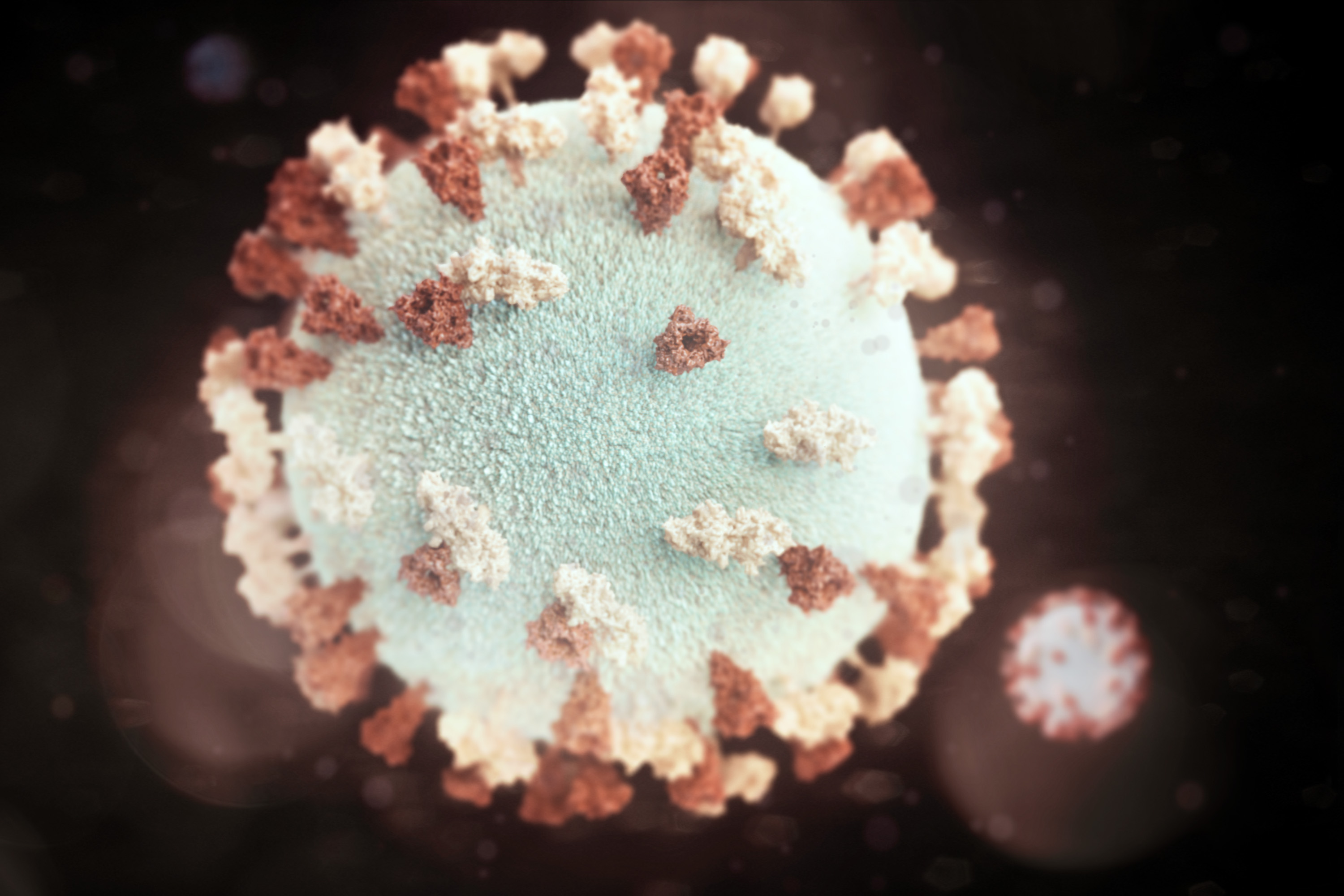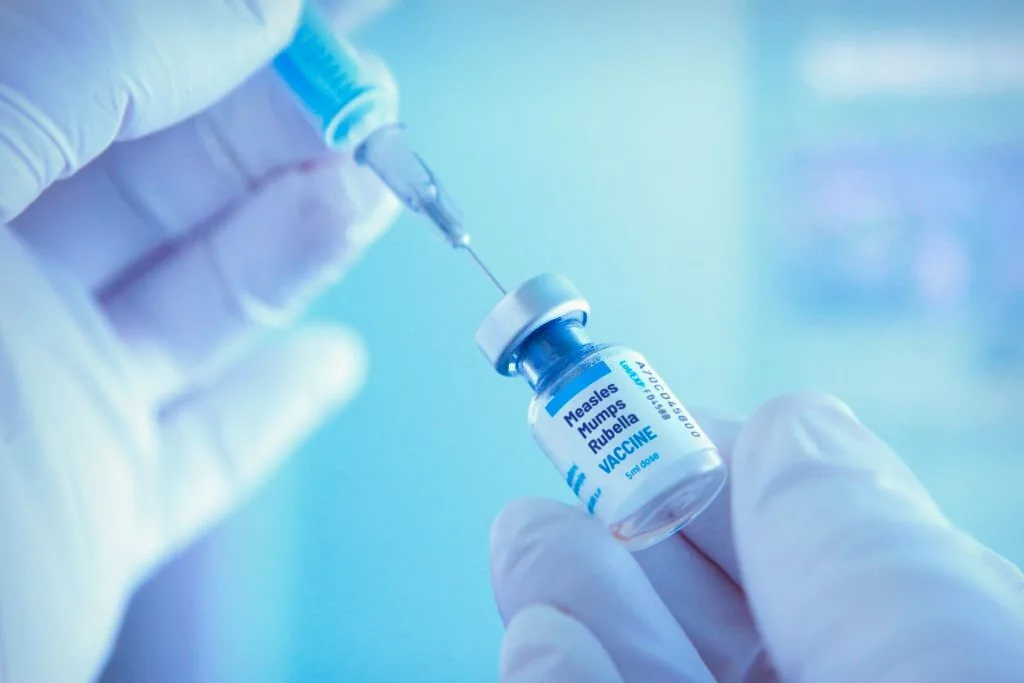Mumps is a viral illness that typically impacts the parotid glands located bilaterally on the face. The parotid glands produce saliva and can cause discomfort and tenderness when they become swollen. The mumps virus mainly leads to symptoms such as fever, headache, muscular aches, weariness, and appetite loss. The swelling of cheeks and jaw is a hallmark sign of mumps. It is caused by salivary gland inflammation. However, this disease can also lead to a distinctive skin manifestation known as the mumps rash.
Mumps rash is a symptom that can occur as part of mumps infection. While not everyone with mumps develops a rash, it is a significant indicator of the disease. The rash is usually one of the later symptoms to appear and may be accompanied by other typical symptoms. Usually, 2-3 days after the salivary gland enlargement, the mumps rash emerges after the onset of other symptoms. Small, pink, or red bumps that may be slightly raised or flat make up the typically mild rash. Although mumps rash can occur anywhere on the body, the face, neck, and torso are the most frequently affected areas.1Hara, M., Koshida, R., & Nakano, T. (2021). Parents’ views on mumps, mumps vaccine, and the factors associated with vaccination in Japan. Vaccine, 39(52), 7677–7683. https://doi.org/10.1016/j.vaccine.2021.11.015
Prompt medical attention is crucial when these symptoms appear. Taking necessary precautions helps prevent virus spread.2Muralitharan, J., Nagarajan, V., & Ravichandran, U. (2022). Mumps and Splenic Abscess: Is There a Link? Cureus, 14(12), e33195. https://doi.org/10.7759/cureus.33195
Are Mumps Contagious?
It is a viral infection that spreads from one person to another through respiratory droplets, such as those released when coughing or sneezing. The mumps can be transmitted by sharing cups and utensils or by contact with an infected person’s saliva. Additionally, the virus can endure on surfaces for several hours, raising the risk of transmission.3Davison, P., & Morris, J. (2022). Mumps. In StatPearls. StatPearls Publishing. People with mumps can spread the virus even if they are asymptomatic because the disease is most contagious in the days before and after the onset of symptoms. The most effective method of preventing mumps is vaccination.
Mumps Causes
The Paramyxoviridae family of viruses, known as the mumps virus, causes mumps. The virus can be transmitted from one person to another through contact with saliva from an infected person or by respiratory droplets, such as those produced when an infected person sneezes or coughs. Additionally, the virus can endure on surfaces for several hours, raising the risk of transmission.

Signs & Symptoms
Mumps manifests as characteristic symptoms, including swelling of salivary glands beneath the ears on one or both sides, resulting in puffy cheeks and a tender, swollen jaw. This condition, parotitis, is the most notable manifestation of mumps. The defining sign of mumps is swelling of the salivary glands, but the virus can also impact other organs, such as the pancreas, ovaries, and testicles.4Su, S. B., Chang, H. L., & Chen, A. K. (2020). Current Status of Mumps Virus Infection: Epidemiology, Pathogenesis, and Vaccine. International journal of environmental research and public health, 17(5), 1686. https://doi.org/10.3390/ijerph17051686
In addition to parotitis, other symptoms may precede the salivary glands’ swelling by a few days. These symptoms can include fever, headache, muscle aches, tiredness, and loss of appetite. As the infection progresses, the immune response triggers the appearance of the mumps rash.
The onset of symptoms typically occurs approximately 16-18 days after the initial infection, although this timeframe can vary from 12 to 25 days.5CDC. (n.d.). Mumps Information for Healthcare Professionals. Retrieved from https://www.cdc.gov/mumps/hcp.html#:~:text=Mumps%20is%20a%20viral%20illness,of%2012%20to%2025%20days. People with the mumps virus can spread it even if they show no symptoms because it is highly contagious.
Precautions For Mumps
There are numerous measures you can take to stop the virus from spreading if you have had the mumps or have been exposed to it:
- If you have mumps, staying at home and avoiding contact with people for at least five days after the start of salivary gland enlargement is crucial. This will prevent the virus from infecting more people.
- When coughing or sneezing, cover your mouth and nose with a tissue or sleeve to stop respiratory droplets from flying around.6Ather, B., Mirza, T. M., & Edemekong, P. F. (2023). Airborne Precautions. In StatPearls. StatPearls Publishing.
- Maintain hand hygiene by regularly washing your hands with soap and water or using hand sanitizer with alcohol, especially after coughing, sneezing, or blowing your nose.
- Sharing towels, cups, and utensils with others can increase the chance of transmission. So, avoid sharing personal items.
Mumps In Adults
Although the mumps virus can infect people of any age, it is more prevalent in children and young adults. Adults who have never received the mumps vaccination or who have never had the illness before are more prone to contracting it. Adults with mumps may experience more severe symptoms and problems than children. The salivary glands’ enlargement, which can produce pain and soreness in the face and jaw, is the most typical sign of mumps. Fever, headache, muscle aches, weariness, and appetite loss are possible additional symptoms. Mumps can occasionally result in consequences including meningitis, orchitis (testicular inflammation), oophoritis (ovarian inflammation), pancreatitis (pancreatic inflammation), and deafness. Adults experience these issues more frequently than kids.7Shanley J. D. (2007). The resurgence of mumps in young adults and adolescents. Cleveland Clinic journal of medicine, 74(1), 42–48. https://doi.org/10.3949/ccjm.74.1.42
Diagnosis
Diagnosing mumps rash involves a combination of clinical evaluation, symptom assessment, and potentially laboratory tests. A healthcare professional will examine the patient’s symptoms, including the rash, and inquire about any recent exposure to the virus. In some cases, blood tests or viral cultures may be conducted to confirm the presence of the mumps virus.
To accurately diagnose an ongoing mumps infection, two distinct types of tests are employed:
- IgM Antibody Test: This test detects the presence of IgM antibodies, specialized proteins produced by the immune system in response to the mumps virus. A blood sample is analyzed to identify IgM antibodies as evidence of an ongoing infection.
- Molecular Tests: Employing various specimens such as blood, nasal/throat fluid, or urine, molecular tests seek out the genetic material of the mumps virus. Polymerase Chain Reaction (PCR) tests, a prevalent molecular technique, play a pivotal role in confirming the presence of the virus.
Mumps Treatment
There is currently no specific medication available for the treatment of mumps. Various measures that alleviate pain and discomfort can manage the symptoms of mumps. Normally, mumps are a mild, self-limiting disease that disappears without sequelae. However, complications may occur, such as encephalitis or sensorineural deafness.
Rest:
Getting enough sleep is crucial so the body can fight the infection and heal.
Drinking fluids:
Drinking plenty of fluids, such as water, juice, and soup, can help to maintain general health and prevent dehydration.
Painkillers:
Over-the-counter painkillers like paracetamol and ibuprofen can reduce fever and relieve pain.
Isolation:
To prevent the spread of the virus, it is crucial to stay away from others. Mump patients should stay home until their symptoms subside and avoid going to school, offices, and other public places.
Warm or Cold Compresses:
Applying warm or cold compresses to the affected areas can provide relief from itching and discomfort associated with the rash
Prevention
The combined vaccine for measles, mumps, and rubella (MMR) offers defense against three distinct viral infections: measles, mumps, and rubella. Healthcare providers often administer the vaccination in two doses, with the first dose given between 12 and 15 months of age and the second dose given between 4 and 6 years of age. The MMR vaccination induces the body’s immune system to create antibodies against these viruses by containing weak or inactivated viruses. After receiving the vaccine, the person’s immune system is prepared to detect and combat any subsequent exposure to these viruses, shielding them from illness or significant repercussions.8Ting, C. Y., Tee, N. W., & Thoon, K. C. (2015). Could a fever and rash after the measles, mumps, and rubella vaccination indicate wild-type measles? Acta paediatrica (Oslo, Norway: 1992), 104(5), e232–e234. https://doi.org/10.1111/apa.12961

The prevalence of these diseases has decreased significantly since the widespread use of the MMR vaccine for many years. However, a tiny but increasing anti-vaccine movement in recent years has called into question the safety and effectiveness of vaccines, especially the MMR vaccine. It is crucial to highlight that no scientific evidence supports these claims, and vaccination is still the most effective strategy to protect against these illnesses and their potentially dangerous side effects.
Determining Mumps Immunity
Individuals vaccinated against or previously infected with measles and mumps often develop long-lasting protection in the form of IgG antibodies. An IgG antibody test, performed on blood samples, gauges the presence of these antibodies, shedding light on an individual’s immune status. A singular blood test, referred to as MMR antibody screening, serves as a versatile tool for diagnosing both measles and mumps, in addition to assessing immunity status.
Conclusion
In conclusion, Mumps rash is a distinct symptom that can develop due to mumps infection. While not everyone with mumps experiences this rash, its presence can aid in diagnosing the disease. Understanding the symptoms, causes, and treatment options for mumps rash is essential for individuals and healthcare professionals in effectively managing and preventing the spread of this viral infection. Mumps can affect people of all ages but is more common in children and young adults. It can be more severe in adults. Getting vaccinated is the best strategy to prevent mumps. If you suspect you have mumps, seek medical attention for diagnosis and take steps to prevent the virus from spreading.
Refrences
- 1Hara, M., Koshida, R., & Nakano, T. (2021). Parents’ views on mumps, mumps vaccine, and the factors associated with vaccination in Japan. Vaccine, 39(52), 7677–7683. https://doi.org/10.1016/j.vaccine.2021.11.015
- 2Muralitharan, J., Nagarajan, V., & Ravichandran, U. (2022). Mumps and Splenic Abscess: Is There a Link? Cureus, 14(12), e33195. https://doi.org/10.7759/cureus.33195
- 3Davison, P., & Morris, J. (2022). Mumps. In StatPearls. StatPearls Publishing.
- 4Su, S. B., Chang, H. L., & Chen, A. K. (2020). Current Status of Mumps Virus Infection: Epidemiology, Pathogenesis, and Vaccine. International journal of environmental research and public health, 17(5), 1686. https://doi.org/10.3390/ijerph17051686
- 5CDC. (n.d.). Mumps Information for Healthcare Professionals. Retrieved from https://www.cdc.gov/mumps/hcp.html#:~:text=Mumps%20is%20a%20viral%20illness,of%2012%20to%2025%20days.
- 6Ather, B., Mirza, T. M., & Edemekong, P. F. (2023). Airborne Precautions. In StatPearls. StatPearls Publishing.
- 7Shanley J. D. (2007). The resurgence of mumps in young adults and adolescents. Cleveland Clinic journal of medicine, 74(1), 42–48. https://doi.org/10.3949/ccjm.74.1.42
- 8Ting, C. Y., Tee, N. W., & Thoon, K. C. (2015). Could a fever and rash after the measles, mumps, and rubella vaccination indicate wild-type measles? Acta paediatrica (Oslo, Norway: 1992), 104(5), e232–e234. https://doi.org/10.1111/apa.12961

